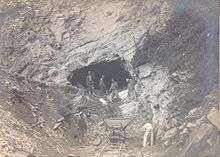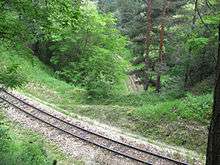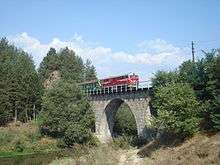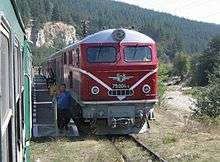Septemvri–Dobrinishte narrow-gauge line
The Septemvri–Dobrinishte narrow-gauge line (Bulgarian: теснолинейка Септември – Добринище, tesnolineyka Septemvri–Dobrinishte) is the only operating 760 mm (2 ft 5 15⁄16 in) narrow-gauge line in Bulgaria. It is operated by Bulgarian State Railways (BDŽ). The line is actively used with four passenger trains running the length of the line in each direction per day. The journey takes five hours through the valleys and gorges between Rila and Rhodopes.
| Septemvri–Dobrinishte | ||||||||||||||||||||||||||||||||||||||||||||||||||||||||||||||||||||||||||||||||||||||||||||||||||||||||||||||||||||||||||||||||||||||||||||||||||||||||||||||||||||||||||||||||||||||||||||||||||||||||||||||||||||||||||||||||||||||||||||||||||||||||||||||||||||||||||||||||||||||||||||||||||||||||||||||||||||||||||||||||||||||||||||||||||||||||||||||||||||||||||||||||||||||||||||||||||||||||||||||||||||||||||||||||
|---|---|---|---|---|---|---|---|---|---|---|---|---|---|---|---|---|---|---|---|---|---|---|---|---|---|---|---|---|---|---|---|---|---|---|---|---|---|---|---|---|---|---|---|---|---|---|---|---|---|---|---|---|---|---|---|---|---|---|---|---|---|---|---|---|---|---|---|---|---|---|---|---|---|---|---|---|---|---|---|---|---|---|---|---|---|---|---|---|---|---|---|---|---|---|---|---|---|---|---|---|---|---|---|---|---|---|---|---|---|---|---|---|---|---|---|---|---|---|---|---|---|---|---|---|---|---|---|---|---|---|---|---|---|---|---|---|---|---|---|---|---|---|---|---|---|---|---|---|---|---|---|---|---|---|---|---|---|---|---|---|---|---|---|---|---|---|---|---|---|---|---|---|---|---|---|---|---|---|---|---|---|---|---|---|---|---|---|---|---|---|---|---|---|---|---|---|---|---|---|---|---|---|---|---|---|---|---|---|---|---|---|---|---|---|---|---|---|---|---|---|---|---|---|---|---|---|---|---|---|---|---|---|---|---|---|---|---|---|---|---|---|---|---|---|---|---|---|---|---|---|---|---|---|---|---|---|---|---|---|---|---|---|---|---|---|---|---|---|---|---|---|---|---|---|---|---|---|---|---|---|---|---|---|---|---|---|---|---|---|---|---|---|---|---|---|---|---|---|---|---|---|---|---|---|---|---|---|---|---|---|---|---|---|---|---|---|---|---|---|---|---|---|---|---|---|---|---|---|---|---|---|---|---|---|---|---|---|---|---|---|---|---|---|---|---|---|---|---|---|---|---|---|---|---|---|---|---|---|---|---|---|---|---|---|---|---|---|---|---|---|---|---|---|---|---|---|---|---|---|---|---|---|---|---|---|---|---|---|---|---|---|---|---|---|---|---|---|---|---|---|---|---|---|---|---|---|---|---|---|---|---|---|---|---|---|---|
| Overview | ||||||||||||||||||||||||||||||||||||||||||||||||||||||||||||||||||||||||||||||||||||||||||||||||||||||||||||||||||||||||||||||||||||||||||||||||||||||||||||||||||||||||||||||||||||||||||||||||||||||||||||||||||||||||||||||||||||||||||||||||||||||||||||||||||||||||||||||||||||||||||||||||||||||||||||||||||||||||||||||||||||||||||||||||||||||||||||||||||||||||||||||||||||||||||||||||||||||||||||||||||||||||||||||||
| Type | Narrow-gauge heavy rail | |||||||||||||||||||||||||||||||||||||||||||||||||||||||||||||||||||||||||||||||||||||||||||||||||||||||||||||||||||||||||||||||||||||||||||||||||||||||||||||||||||||||||||||||||||||||||||||||||||||||||||||||||||||||||||||||||||||||||||||||||||||||||||||||||||||||||||||||||||||||||||||||||||||||||||||||||||||||||||||||||||||||||||||||||||||||||||||||||||||||||||||||||||||||||||||||||||||||||||||||||||||||||||||||
| System | Bulgarian railways | |||||||||||||||||||||||||||||||||||||||||||||||||||||||||||||||||||||||||||||||||||||||||||||||||||||||||||||||||||||||||||||||||||||||||||||||||||||||||||||||||||||||||||||||||||||||||||||||||||||||||||||||||||||||||||||||||||||||||||||||||||||||||||||||||||||||||||||||||||||||||||||||||||||||||||||||||||||||||||||||||||||||||||||||||||||||||||||||||||||||||||||||||||||||||||||||||||||||||||||||||||||||||||||||
| Status | Operating | |||||||||||||||||||||||||||||||||||||||||||||||||||||||||||||||||||||||||||||||||||||||||||||||||||||||||||||||||||||||||||||||||||||||||||||||||||||||||||||||||||||||||||||||||||||||||||||||||||||||||||||||||||||||||||||||||||||||||||||||||||||||||||||||||||||||||||||||||||||||||||||||||||||||||||||||||||||||||||||||||||||||||||||||||||||||||||||||||||||||||||||||||||||||||||||||||||||||||||||||||||||||||||||||
| Locale | Rhodope and Rila mountains, Bulgaria | |||||||||||||||||||||||||||||||||||||||||||||||||||||||||||||||||||||||||||||||||||||||||||||||||||||||||||||||||||||||||||||||||||||||||||||||||||||||||||||||||||||||||||||||||||||||||||||||||||||||||||||||||||||||||||||||||||||||||||||||||||||||||||||||||||||||||||||||||||||||||||||||||||||||||||||||||||||||||||||||||||||||||||||||||||||||||||||||||||||||||||||||||||||||||||||||||||||||||||||||||||||||||||||||
| Termini | Septemvri 42°12′14″N 24°7′50″E Dobrinishte 41°49′31″N 23°33′44″E | |||||||||||||||||||||||||||||||||||||||||||||||||||||||||||||||||||||||||||||||||||||||||||||||||||||||||||||||||||||||||||||||||||||||||||||||||||||||||||||||||||||||||||||||||||||||||||||||||||||||||||||||||||||||||||||||||||||||||||||||||||||||||||||||||||||||||||||||||||||||||||||||||||||||||||||||||||||||||||||||||||||||||||||||||||||||||||||||||||||||||||||||||||||||||||||||||||||||||||||||||||||||||||||||
| Stations | 25 | |||||||||||||||||||||||||||||||||||||||||||||||||||||||||||||||||||||||||||||||||||||||||||||||||||||||||||||||||||||||||||||||||||||||||||||||||||||||||||||||||||||||||||||||||||||||||||||||||||||||||||||||||||||||||||||||||||||||||||||||||||||||||||||||||||||||||||||||||||||||||||||||||||||||||||||||||||||||||||||||||||||||||||||||||||||||||||||||||||||||||||||||||||||||||||||||||||||||||||||||||||||||||||||||
| Train number(s) | 16XXX | |||||||||||||||||||||||||||||||||||||||||||||||||||||||||||||||||||||||||||||||||||||||||||||||||||||||||||||||||||||||||||||||||||||||||||||||||||||||||||||||||||||||||||||||||||||||||||||||||||||||||||||||||||||||||||||||||||||||||||||||||||||||||||||||||||||||||||||||||||||||||||||||||||||||||||||||||||||||||||||||||||||||||||||||||||||||||||||||||||||||||||||||||||||||||||||||||||||||||||||||||||||||||||||||
| Operation | ||||||||||||||||||||||||||||||||||||||||||||||||||||||||||||||||||||||||||||||||||||||||||||||||||||||||||||||||||||||||||||||||||||||||||||||||||||||||||||||||||||||||||||||||||||||||||||||||||||||||||||||||||||||||||||||||||||||||||||||||||||||||||||||||||||||||||||||||||||||||||||||||||||||||||||||||||||||||||||||||||||||||||||||||||||||||||||||||||||||||||||||||||||||||||||||||||||||||||||||||||||||||||||||||
| Opened | Aug 1, 1926 / Dec 9, 1945 | |||||||||||||||||||||||||||||||||||||||||||||||||||||||||||||||||||||||||||||||||||||||||||||||||||||||||||||||||||||||||||||||||||||||||||||||||||||||||||||||||||||||||||||||||||||||||||||||||||||||||||||||||||||||||||||||||||||||||||||||||||||||||||||||||||||||||||||||||||||||||||||||||||||||||||||||||||||||||||||||||||||||||||||||||||||||||||||||||||||||||||||||||||||||||||||||||||||||||||||||||||||||||||||||
| Owner | NRIC | |||||||||||||||||||||||||||||||||||||||||||||||||||||||||||||||||||||||||||||||||||||||||||||||||||||||||||||||||||||||||||||||||||||||||||||||||||||||||||||||||||||||||||||||||||||||||||||||||||||||||||||||||||||||||||||||||||||||||||||||||||||||||||||||||||||||||||||||||||||||||||||||||||||||||||||||||||||||||||||||||||||||||||||||||||||||||||||||||||||||||||||||||||||||||||||||||||||||||||||||||||||||||||||||
| Operator(s) | BDZ | |||||||||||||||||||||||||||||||||||||||||||||||||||||||||||||||||||||||||||||||||||||||||||||||||||||||||||||||||||||||||||||||||||||||||||||||||||||||||||||||||||||||||||||||||||||||||||||||||||||||||||||||||||||||||||||||||||||||||||||||||||||||||||||||||||||||||||||||||||||||||||||||||||||||||||||||||||||||||||||||||||||||||||||||||||||||||||||||||||||||||||||||||||||||||||||||||||||||||||||||||||||||||||||||
| Technical | ||||||||||||||||||||||||||||||||||||||||||||||||||||||||||||||||||||||||||||||||||||||||||||||||||||||||||||||||||||||||||||||||||||||||||||||||||||||||||||||||||||||||||||||||||||||||||||||||||||||||||||||||||||||||||||||||||||||||||||||||||||||||||||||||||||||||||||||||||||||||||||||||||||||||||||||||||||||||||||||||||||||||||||||||||||||||||||||||||||||||||||||||||||||||||||||||||||||||||||||||||||||||||||||||
| Line length | 125.0 km (77.7 mi) | |||||||||||||||||||||||||||||||||||||||||||||||||||||||||||||||||||||||||||||||||||||||||||||||||||||||||||||||||||||||||||||||||||||||||||||||||||||||||||||||||||||||||||||||||||||||||||||||||||||||||||||||||||||||||||||||||||||||||||||||||||||||||||||||||||||||||||||||||||||||||||||||||||||||||||||||||||||||||||||||||||||||||||||||||||||||||||||||||||||||||||||||||||||||||||||||||||||||||||||||||||||||||||||||
| Number of tracks | Single track | |||||||||||||||||||||||||||||||||||||||||||||||||||||||||||||||||||||||||||||||||||||||||||||||||||||||||||||||||||||||||||||||||||||||||||||||||||||||||||||||||||||||||||||||||||||||||||||||||||||||||||||||||||||||||||||||||||||||||||||||||||||||||||||||||||||||||||||||||||||||||||||||||||||||||||||||||||||||||||||||||||||||||||||||||||||||||||||||||||||||||||||||||||||||||||||||||||||||||||||||||||||||||||||||
| Track gauge | 760 mm (2 ft 5 15⁄16 in) Bosnian gauge | |||||||||||||||||||||||||||||||||||||||||||||||||||||||||||||||||||||||||||||||||||||||||||||||||||||||||||||||||||||||||||||||||||||||||||||||||||||||||||||||||||||||||||||||||||||||||||||||||||||||||||||||||||||||||||||||||||||||||||||||||||||||||||||||||||||||||||||||||||||||||||||||||||||||||||||||||||||||||||||||||||||||||||||||||||||||||||||||||||||||||||||||||||||||||||||||||||||||||||||||||||||||||||||||
| Minimum radius | 60 m (197 ft) | |||||||||||||||||||||||||||||||||||||||||||||||||||||||||||||||||||||||||||||||||||||||||||||||||||||||||||||||||||||||||||||||||||||||||||||||||||||||||||||||||||||||||||||||||||||||||||||||||||||||||||||||||||||||||||||||||||||||||||||||||||||||||||||||||||||||||||||||||||||||||||||||||||||||||||||||||||||||||||||||||||||||||||||||||||||||||||||||||||||||||||||||||||||||||||||||||||||||||||||||||||||||||||||||
| Electrification | None | |||||||||||||||||||||||||||||||||||||||||||||||||||||||||||||||||||||||||||||||||||||||||||||||||||||||||||||||||||||||||||||||||||||||||||||||||||||||||||||||||||||||||||||||||||||||||||||||||||||||||||||||||||||||||||||||||||||||||||||||||||||||||||||||||||||||||||||||||||||||||||||||||||||||||||||||||||||||||||||||||||||||||||||||||||||||||||||||||||||||||||||||||||||||||||||||||||||||||||||||||||||||||||||||
| Operating speed | 30–50 km/h (19–31 mph) | |||||||||||||||||||||||||||||||||||||||||||||||||||||||||||||||||||||||||||||||||||||||||||||||||||||||||||||||||||||||||||||||||||||||||||||||||||||||||||||||||||||||||||||||||||||||||||||||||||||||||||||||||||||||||||||||||||||||||||||||||||||||||||||||||||||||||||||||||||||||||||||||||||||||||||||||||||||||||||||||||||||||||||||||||||||||||||||||||||||||||||||||||||||||||||||||||||||||||||||||||||||||||||||||
| Highest elevation | 1,267 m (4,157 ft) | |||||||||||||||||||||||||||||||||||||||||||||||||||||||||||||||||||||||||||||||||||||||||||||||||||||||||||||||||||||||||||||||||||||||||||||||||||||||||||||||||||||||||||||||||||||||||||||||||||||||||||||||||||||||||||||||||||||||||||||||||||||||||||||||||||||||||||||||||||||||||||||||||||||||||||||||||||||||||||||||||||||||||||||||||||||||||||||||||||||||||||||||||||||||||||||||||||||||||||||||||||||||||||||||
| Maximum incline | 3.2% | |||||||||||||||||||||||||||||||||||||||||||||||||||||||||||||||||||||||||||||||||||||||||||||||||||||||||||||||||||||||||||||||||||||||||||||||||||||||||||||||||||||||||||||||||||||||||||||||||||||||||||||||||||||||||||||||||||||||||||||||||||||||||||||||||||||||||||||||||||||||||||||||||||||||||||||||||||||||||||||||||||||||||||||||||||||||||||||||||||||||||||||||||||||||||||||||||||||||||||||||||||||||||||||||
| Route number | 16 / 116 | |||||||||||||||||||||||||||||||||||||||||||||||||||||||||||||||||||||||||||||||||||||||||||||||||||||||||||||||||||||||||||||||||||||||||||||||||||||||||||||||||||||||||||||||||||||||||||||||||||||||||||||||||||||||||||||||||||||||||||||||||||||||||||||||||||||||||||||||||||||||||||||||||||||||||||||||||||||||||||||||||||||||||||||||||||||||||||||||||||||||||||||||||||||||||||||||||||||||||||||||||||||||||||||||
| ||||||||||||||||||||||||||||||||||||||||||||||||||||||||||||||||||||||||||||||||||||||||||||||||||||||||||||||||||||||||||||||||||||||||||||||||||||||||||||||||||||||||||||||||||||||||||||||||||||||||||||||||||||||||||||||||||||||||||||||||||||||||||||||||||||||||||||||||||||||||||||||||||||||||||||||||||||||||||||||||||||||||||||||||||||||||||||||||||||||||||||||||||||||||||||||||||||||||||||||||||||||||||||||||
The route leads from Septemvri on the mainline Sofia–Plovdiv to Dobrinishte, passing Velingrad, Yakoruda, Razlog and Bansko, linking the western part of the Upper Thracian Plain with the Western Rhodopes, Rila and Pirin mountains. Due to the characteristics of the route through the mountains, the narrow-gauge line Septemvri–Dobrinishte is also known as the Alpine railway in the Balkans. Avramovo station, situated at 1267 meters above the sea, is the highest station in the Balkans.
The railway was built in several stages between 1921 and 1945 with total length of 125 km (78 miles). The Varvara–Pazardzhik branch line, which was closed in 2002, was 16.6 km (10.3 miles) long.
History

The idea for a railway, serving the Rhodope Mountains dating from 1915, when three possible paths are represented. In 1916 due to military reasons during WWI, the army wanted to link the town of Nevrokop (now Gotse Delchev) to the railway network and started surveying the first section from Sarambey (now Septemvri) to Ladzhene (now part of Velingrad). However, when the war ended, the work was stopped.
In 1920, the surveying resumed, followed by construction in 1921. In the hard years after the war, the progress was poor, with work done primarily by hand. The track reached Ladzhene in 1926, and the section opened Aug 1, 1926 with three trains per week in each direction. The next short section to Chepino (now Velingrad south) was completed on June 3, 1927.
When Sarambey became the starting point of the line, the population of Pazardzhik feared their town would be away from the traffic and requested a branch of the new railway, which was completed and opened on Oct 27, 1928. This path was chosen to be the main and the railway became Pazardzhik - Chepino with a branch from Varvara - Pazardzhik - Sarambey. This period is short and the section remains a branch until its closing in 2002. Now the track to Pazardzhik is removed.
Construction of the hardest section, Chepino–Yakoruda continued up to 1937, when on 12th Dec it was opened for temporary service. The final opening was Jul 30, 1939, together with the section Yakoruda–Belitsa.
The final sections Belitsa–Bansko and Bansko–Dobrinishte are opened on Mar 3, 1943 and Dec 9, 1945, and the plan for railway to Gotse Delchev had been stopped.
Route description
Septemvri–Velingrad
This first part is 39 km long. It starts at Septemvri, where it meets the standard-gauge railway line Sofia–Plovdiv. After almost straight 6 km long section in the plain, the route reaches station Varvara, the former junction with the removed branch to Pazardzhik. Then the route passes the river Chepinska (also known as Elidere) and the road to Velingrad onto a steel bridge and continues on the left (eastern) bank of the river. As a part of the road widening work, the bridge has to be destroyed and replaced with new one.

Along the gorge, the line passes stops Marko Nikolov (ex Mineral baths), Tsepina (ex Dorkovo), the river again and the road at manually operated level crossing, to reach station Dolene, where it continues in the opposite direction on the other side of the valley, climbing 246 m level displacement to drainage divide Chukata and station Kostandovo ( 801 m ASL) in 10.9 km. Here is the maximum slope of the route of 32 ‰. After passing this station, the route declines to Velingrad valley.
In the beginning there are also stops Milevi skali at km 17.5 between Tsepina and Dolene and Dryanov dol between Dolene and Kostandovo. In the period of heavy traffic in 60s and 70s, Dryanov dol is extended with passing loop and becomes a station, but then it is completely closed, together with Milevi skali. Tsepina also had been station with passing loop and sidings, removed in 2003.
All 10 tunnels on this part of the railway are between Marko Nikolov and Dolene. In April 1928 as a result of the Chirpan earthquake (M6.8), a huge amount of rocks collapses over the track at km 11.7. A new tunnel Nr 2 is constructed to avoid the low radius curves of the temporary track around the collapse. The abandoned old tunnel is still existing next to the new one. It is visible from the road, but not from the train. The open track between tunnels Nr 3, 4, 5, 6, 7, 8 is now covered to prevent another rock collapses on the route.
Velingrad–Yakoruda


This is the hardest section of Septemvri–Dobrinishte railway. It is 45 km long and all four spirals, 25 remaining tunnels and the highest railway station on the Balkans are here. Beginning from Velingrad, through Velingrad south stop, the line starts to climb along the right side of river Ablanitsa, heading Ostrets stop and station Tsvetino. A few kilometers after Tsvetino, the route turns to the right through the valley of the small river Lyuta reka, reaching the former station, now minor stop Sveta Petka.
Here the route starts climbing 224 m in 9.8 km distance to station Avramovo, which is the highest railway station on the Balkans at 1267 m above sea level. Just after Tunnel Nr 16, the track passes a stone arch bridge over the river and begins its four-level way on the north side of the valley through 16 tunnels, two spirals and one 180° turn. The line passes under itself two times in tunnels Nr 18 and 24. In this section, the train changes its traveling direction 6 times. The average incline is 30 ‰. The climbing ends at station Avramovo just after tunnel Nr 32, which is the longest one – 315 m.
This highest point is followed by steep and long descent in the valley of river Dreshtenets. After the Smolevo stop, the line turns at the third spiral, passing under itself in tunnel Nr 34. Just after the spiral, the route overpasses the river and the road on a stone arch viaduct, followed by the fourth spiral around a natural hill, where is the last tunnel Nr 35. Reaching Cherna Mesta stop, the track continues to Yakoruda through the valley of river Mesta.
Sveta Petka and Cherna Mesta are former stations, which have had passing loops and sidings. Between Sveta Petka and Avramovo there is also a closed stop for the nearby village Pashovo.
Yakoruda–Dobrinishte

The last part of the railway has much better parameters, because most of the route is traced for standard-gauge railway, which had been planned to replace the narrow-gauge track in future. After stops Yurukovo and Dagonovo, the line passes station Belitsa and continues to General Kovachev stop, where it leaves the valley of river Mesta and heading Razlog through the valley of smaller river, named Iztok. In his end, the track passes the longest bridge over the river – 58 m long stone viaduct with four arches. It is followed by Guliyna banya stop and after this point the railway continues in the Razlog plain and reaches its final station Dobrinishte through Razlog and Bansko.

In Razlog there had been a small branch, serving some industry near the town. It is source of the last freight traffic until 2003, when closed and removed.

Traffic and rolling stock
| List of locomotives | ||
| Fleet no. | Delivery | Status |
|---|---|---|
| 60976 | 1949 | in service |
| 75 002 | 1966 | out of service |
| 75 004 | 1966 | in service |
| 75 005 | 1966 | out of service |
| 75 006 | 1966 | in service |
| 75 008 | 1966 | in service |
| 75 009 | 1966 | out of service |
| 77 002 | 1988 | in service |
| 77 005 | 1988 | in service |
| 77 008 | 1988 | in service |
| 77 009 | 1988 | in service |
| Note: the missing numbers are scrapped or sold. | ||
The first rolling stock is brought from the other narrow-gauge railway Cherven bryag–Oryahovo (now closed), which is already built in 1926. Operation of the section Sarambey - Ladzhene begins with four small steam engines (0-6-2T, UIC class C1′ n2vPt) of the 176 – 1076 series. They can haul 3–5 cars in the main slopes. In this period there is one pair of mixed trains and two pairs of freight trains per day. In 1928 there is a delivery of four steam engines of the 50076 series (0-10-0T, E h2Gt) and in 1931 two more engines of the same class. The first five engines of the 60076 series (2-10-2T, 1′E1′ h2Gt) are delivered in 1940 and the other 10 ones in 1949–1950. Three diesel railcars of class 81 were delivered from Ganz Works in 1941 and additional four of class 82 in 1952 for long distance passenger trains.[1]
In the 60s and 70s the traffic is too busy for the steam engines and railcars, so in 1965 and 1966 ten diesel engines are delivered from Henschel AG. They are working as class 75 and are still in service now. Most of the steam engines are then brought in Cherven bryag. As an example, in these years there had been more than 10 trains (passenger, freight and mixed) daily in each direction.
Ten engines of class 77 are delivered in 1988 from 23 August Works of Bucharest, Romania, but five of them are sold to RFIRT (now YCF), Argentina in 1996. Before this delivery, some engines class 76 also had been working on the Septemvri–Dobrinishte railway while the others are based on the Cherven bryag–Oryahovo railway.
Steam locomotive 60976 is the only preserved in working condition and used for tourist trains.
Since 2003 there is only passenger service with three trains per day in each direction. As of 2016, there are now four trains running the entire length of the line each day. The current plan can be found on the website of Bulgarian State Railways.
In 1982, Bulgarian industry ordered 10 narrow-gauge shunting diesels of Soviet locomotive class ТУ7 (TU7E) (BDŽ class 81) from the Russian Kambarka Engineering Works.
Gallery
- Septemvri station
- Pamporovo station
- Varvara station
- Marko Nikolov station
- Tsepina station
- Dolene station
- Kostandovo station
- Velingrad station
- Velingrad-south station
- Ostrets station
- Tsvetino station
- Sveta Petka station
- Pashovo station
- Avramovo station
- Smolevo station
- Cherna Mesta station
- Yakoruda station
- Yurukovo station
- Dagonovo station
- Belitsa station
- General Kovachev station
- Guliyna banya station
- Razlog station
- Bansko station
- Sveti Georgi station
- Dobrinishte station
References
- Vaklinov, Kristian. "Diesel Train Engines". The Rhodope Narrow Gauge. Родопската теснолинейка. Retrieved 2018-02-08.
- Deyanov, D. "80 years of narrow-gauge railway Septemvri–Velingrad", Railway transport magazine (in Bulgarian), Vol. 7-8, 2006 ISSN 1310-683X.
- Deyanov, D. Railway network in Bulgaria 1866–1975 (in Bulgarian), Sofia 2005, ISBN 954-9364-05-4.
- Deyanov D, Deyanov S. Locomotives of Bulgarian state railways (in Bulgarian), Sofia 2008, ISBN 978-954-12-0150-3.
Further reading
- Paul Engelbert: Schmalspurig durch Bulgarien, Verlag Stenvalls, Malmö 2002, ISBN 91-7266-155-0
- Rudolf Heym: 125 Kilometer auf schmaler Spur, Lok-Magazin 4/2008, ISSN 0458-1822
External links
| Wikimedia Commons has media related to Septemvri-Dobrinishte narrow gauge line. |